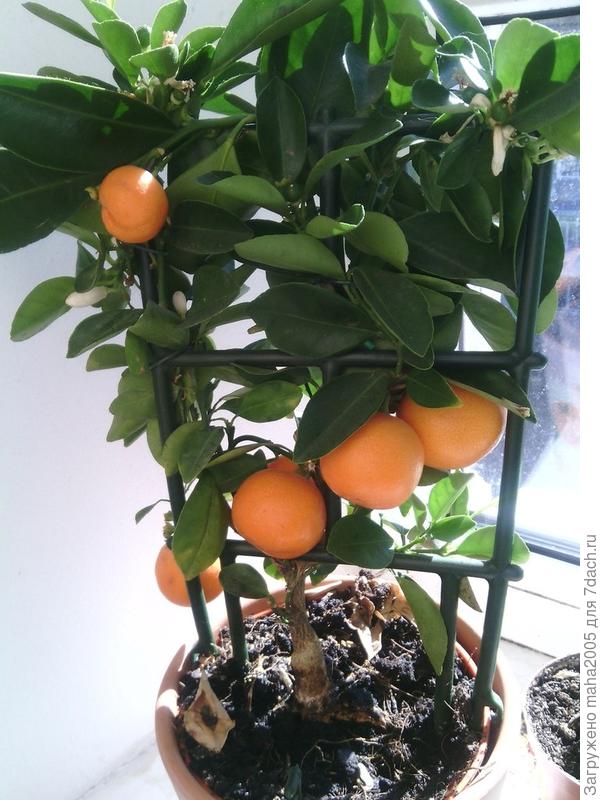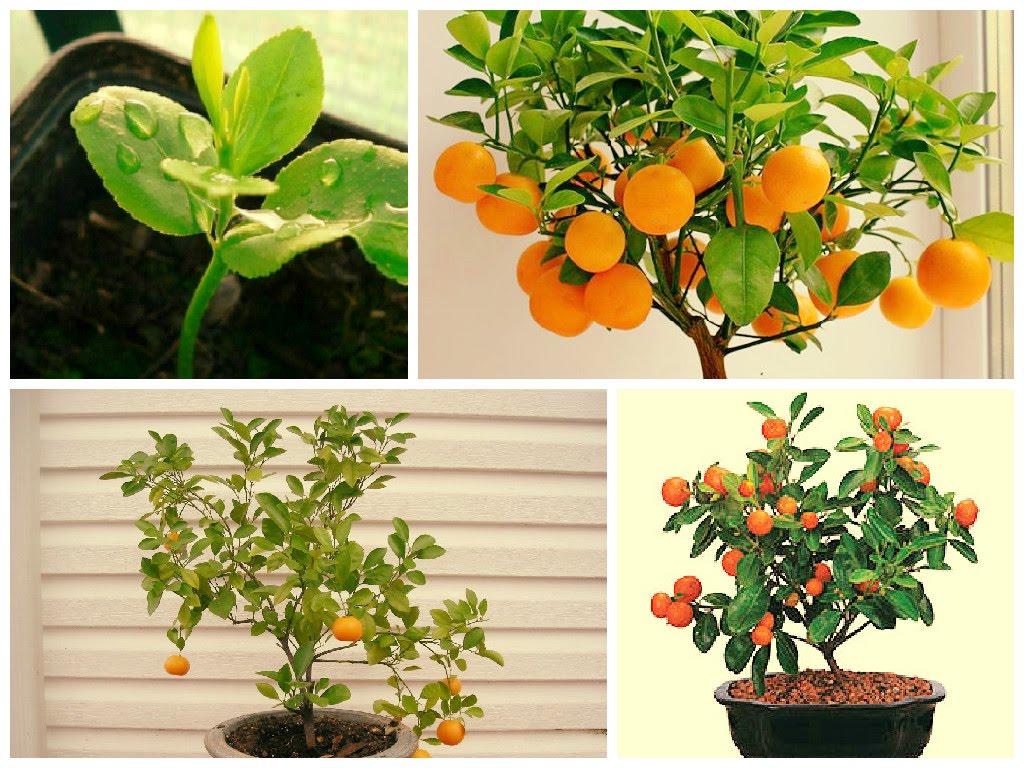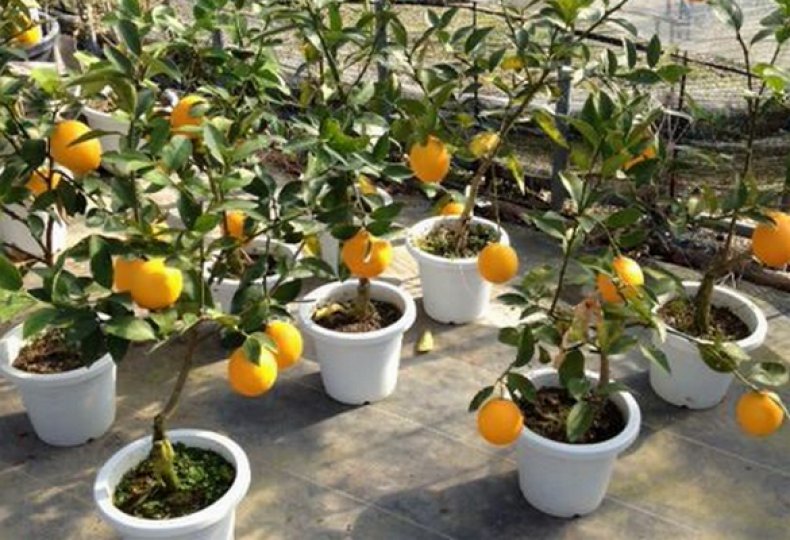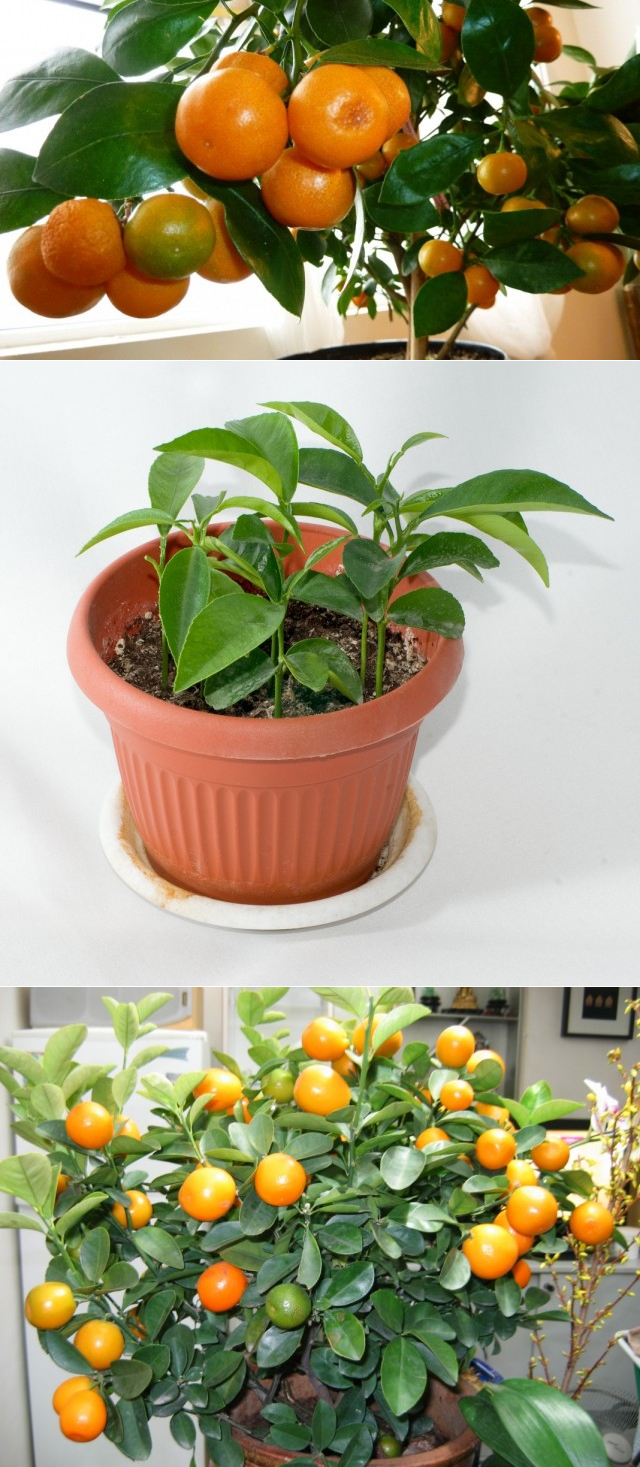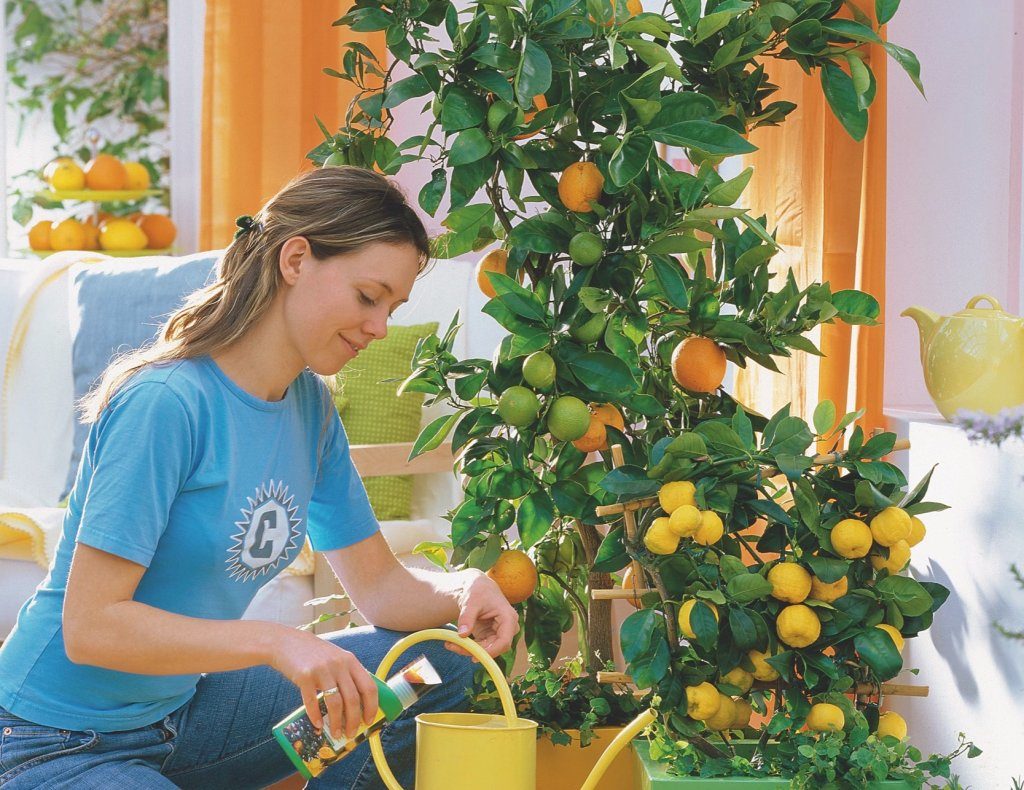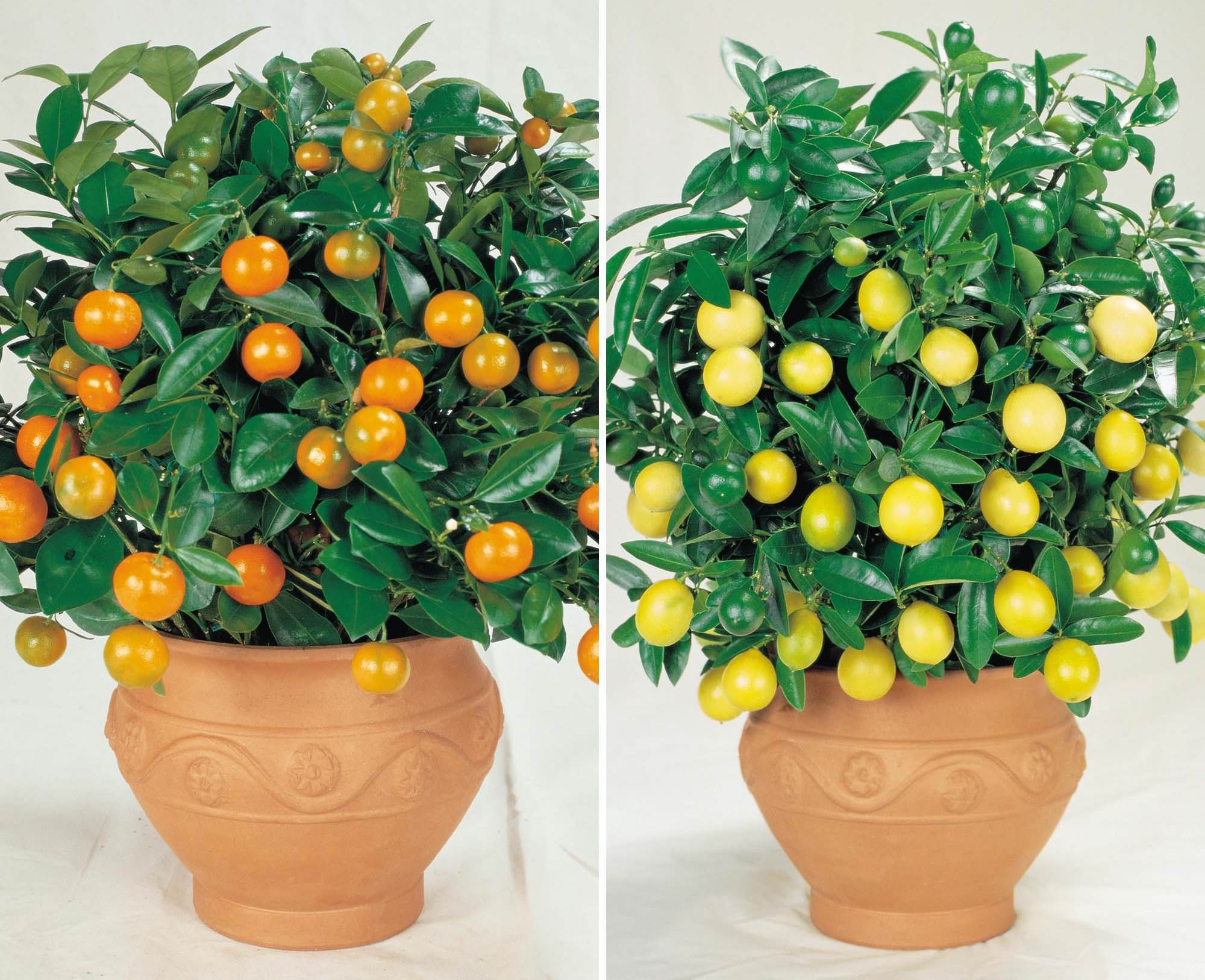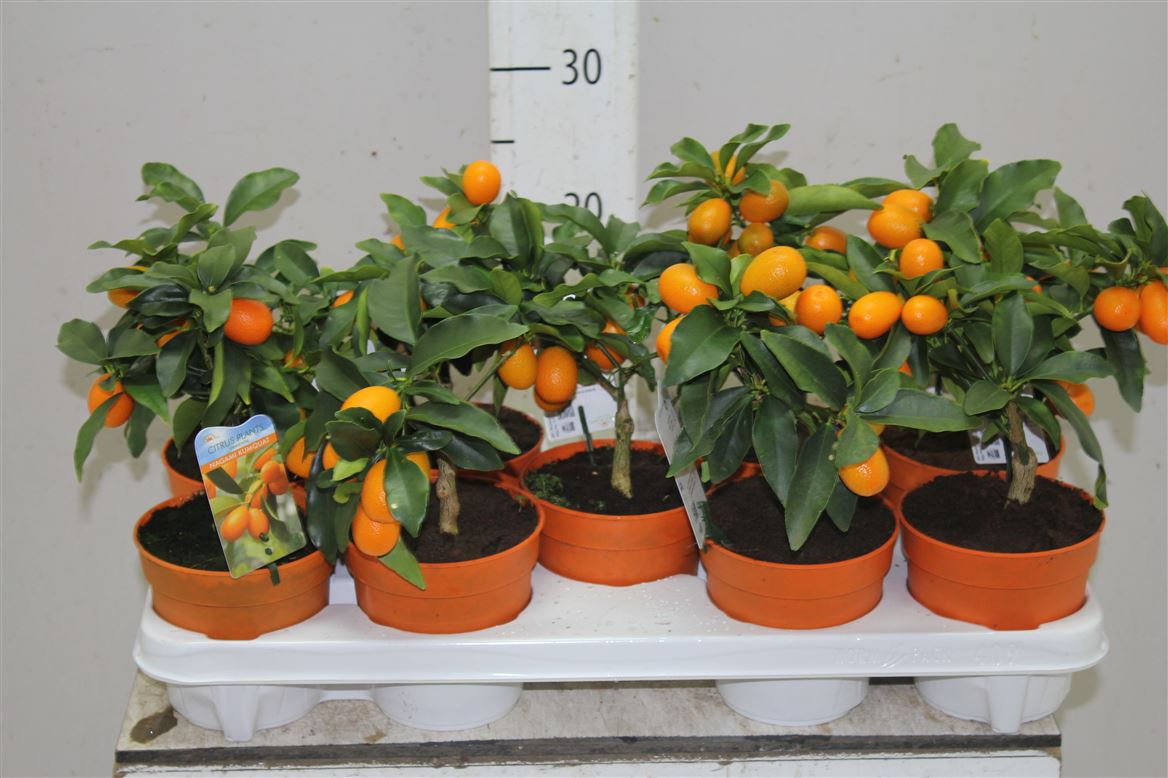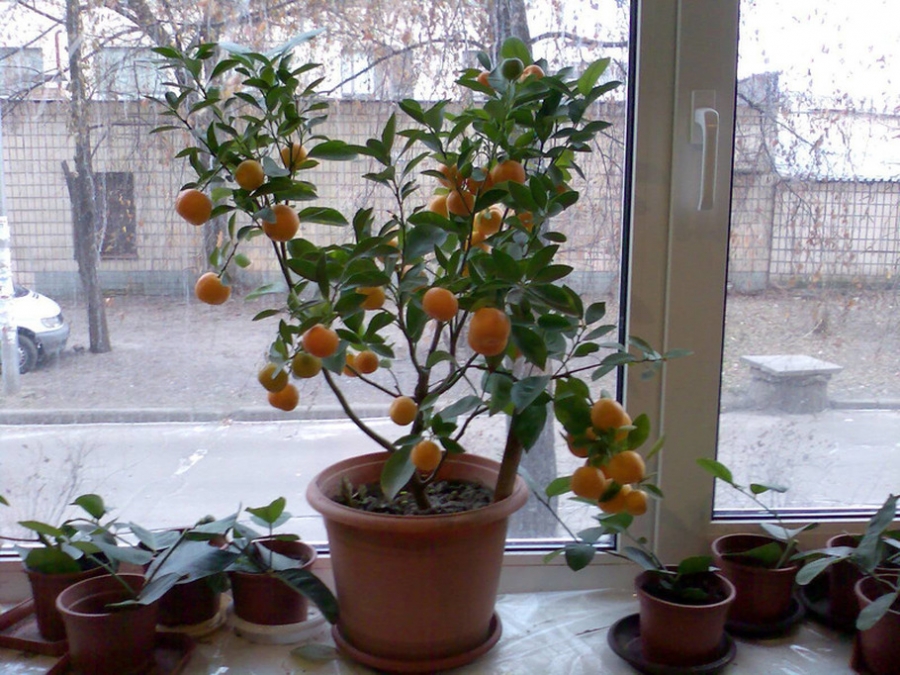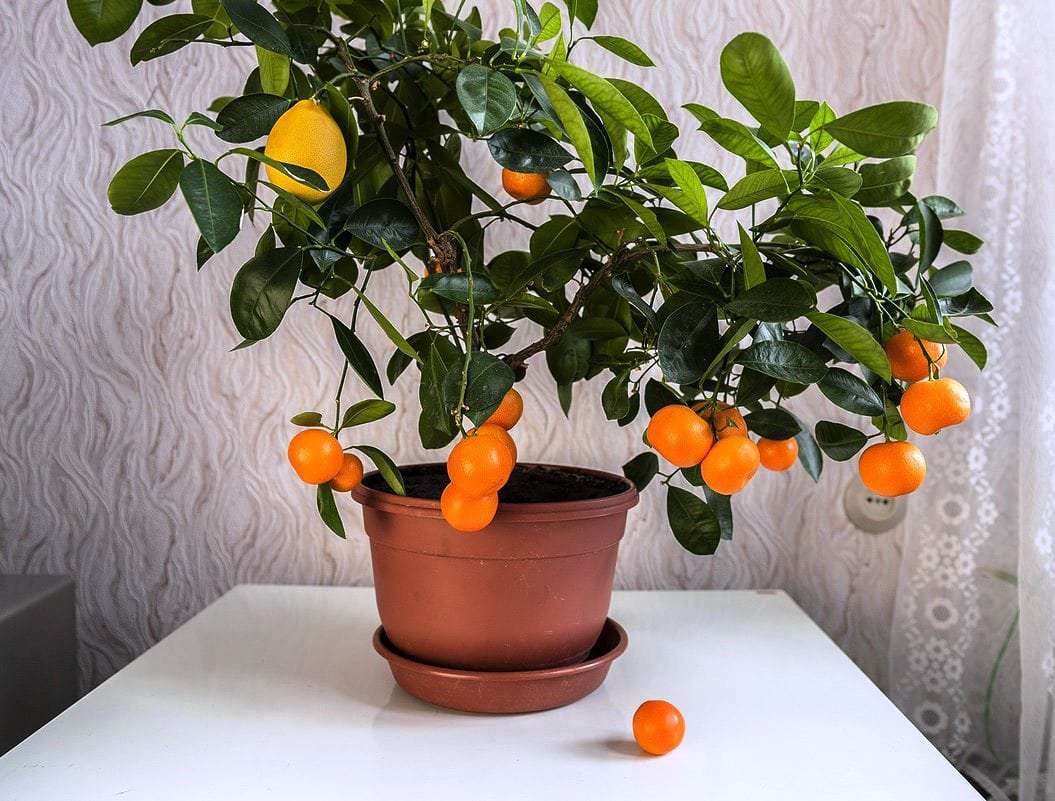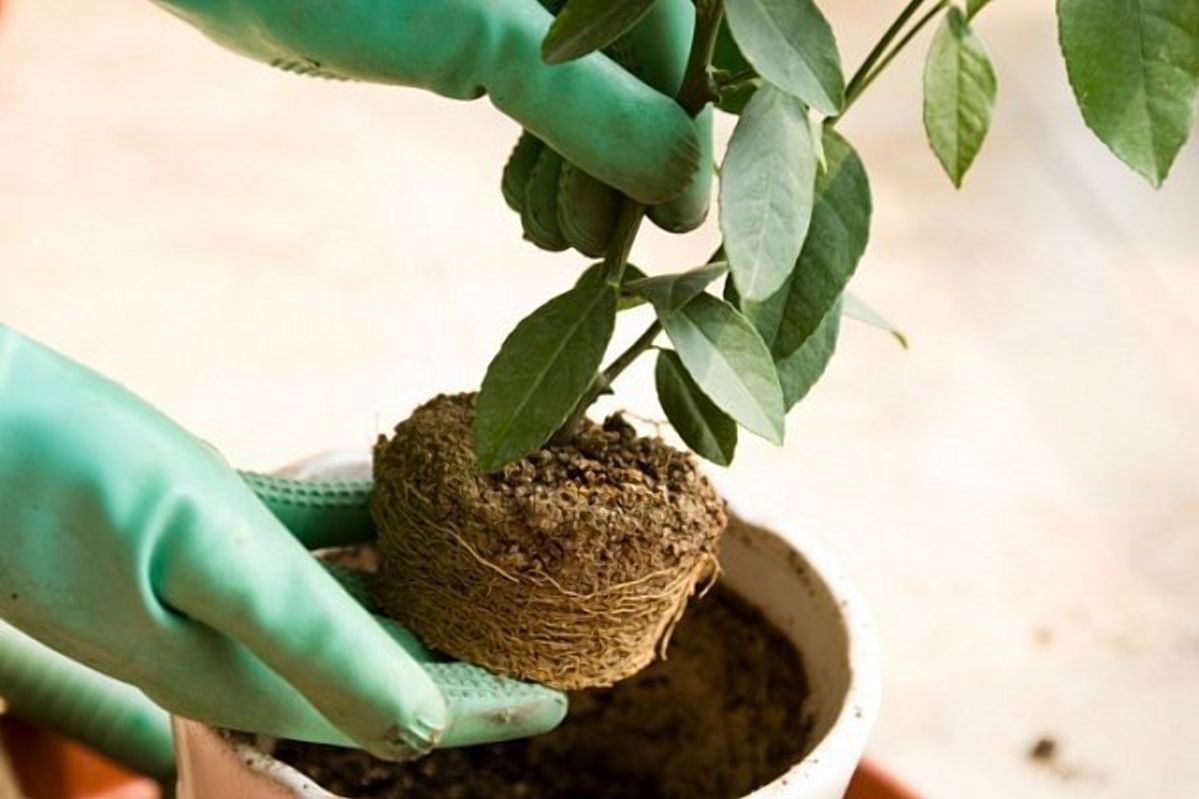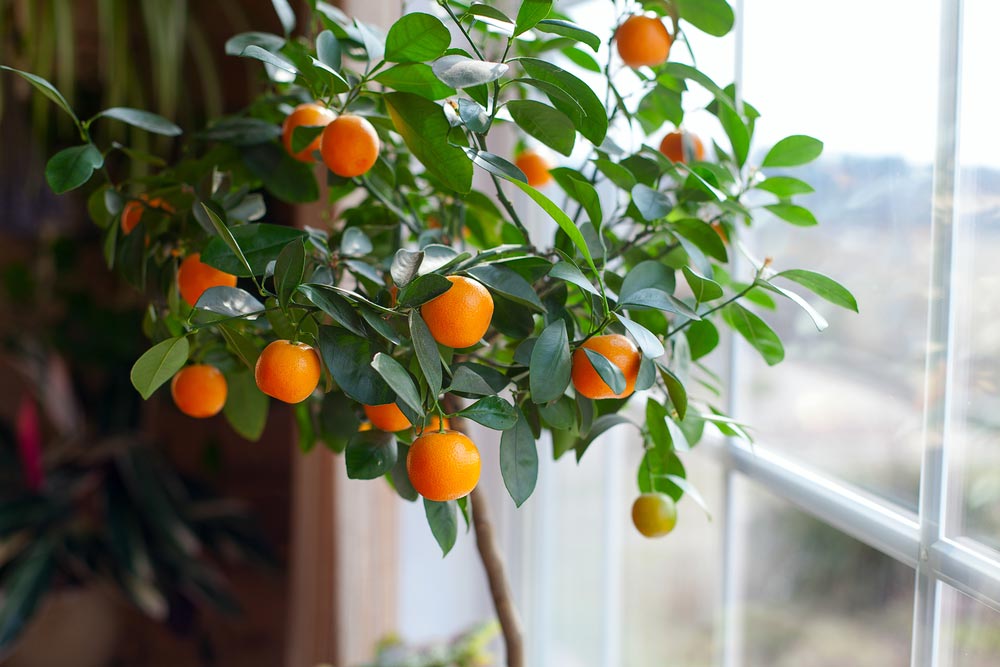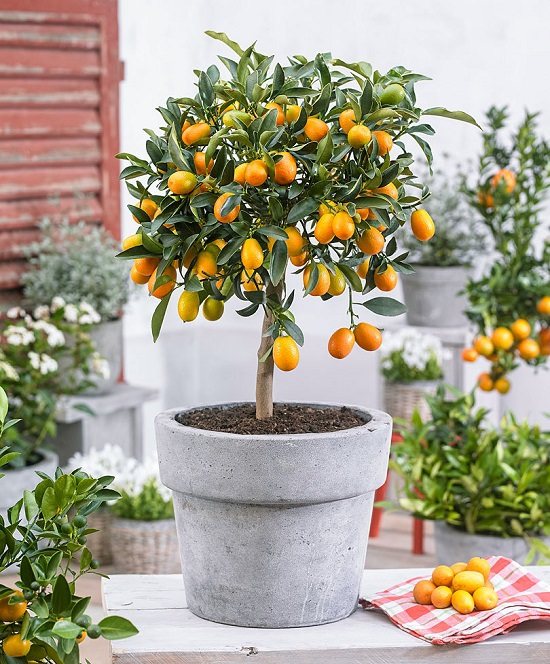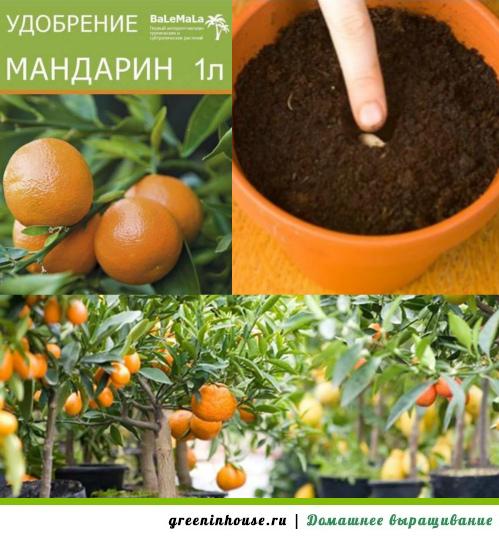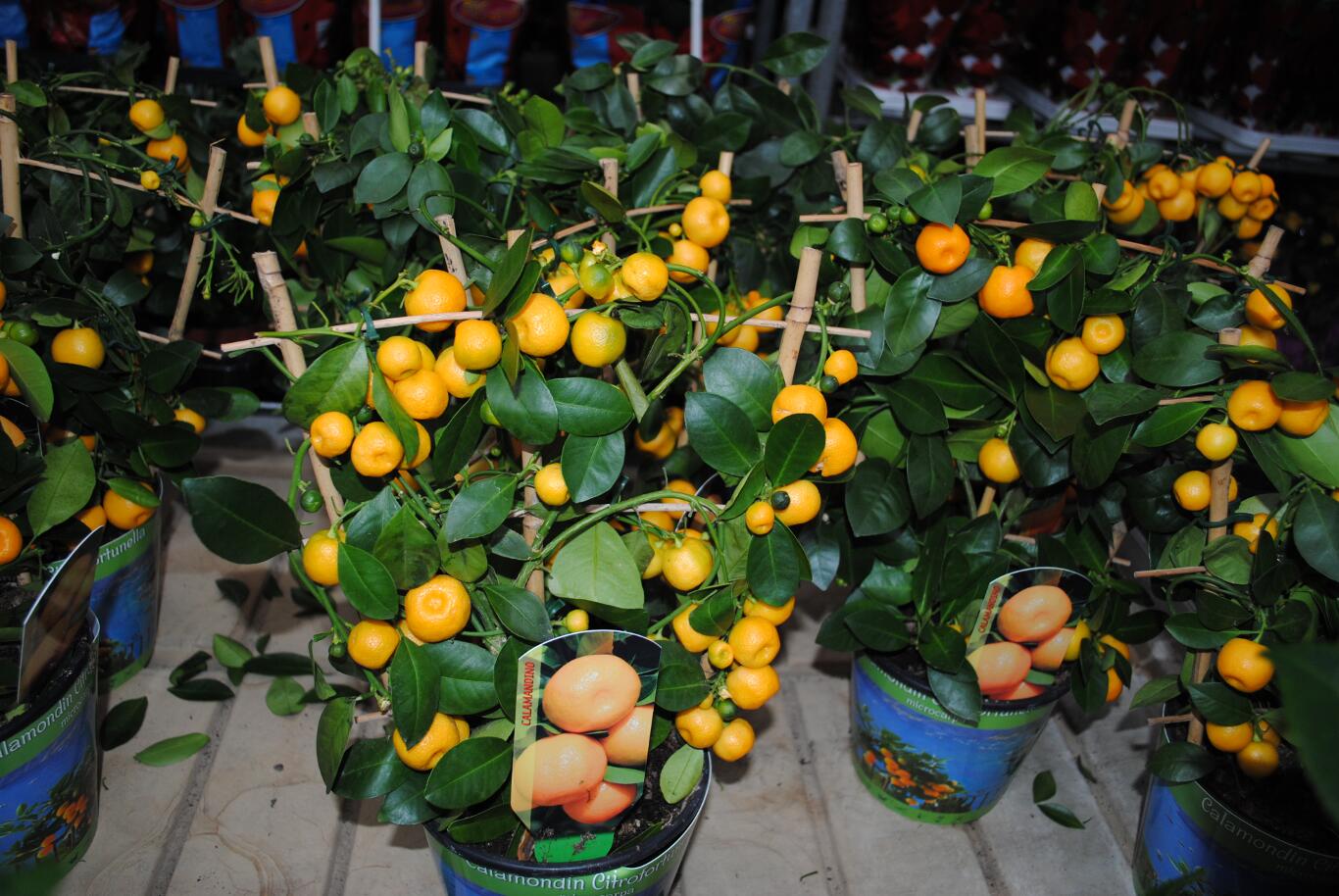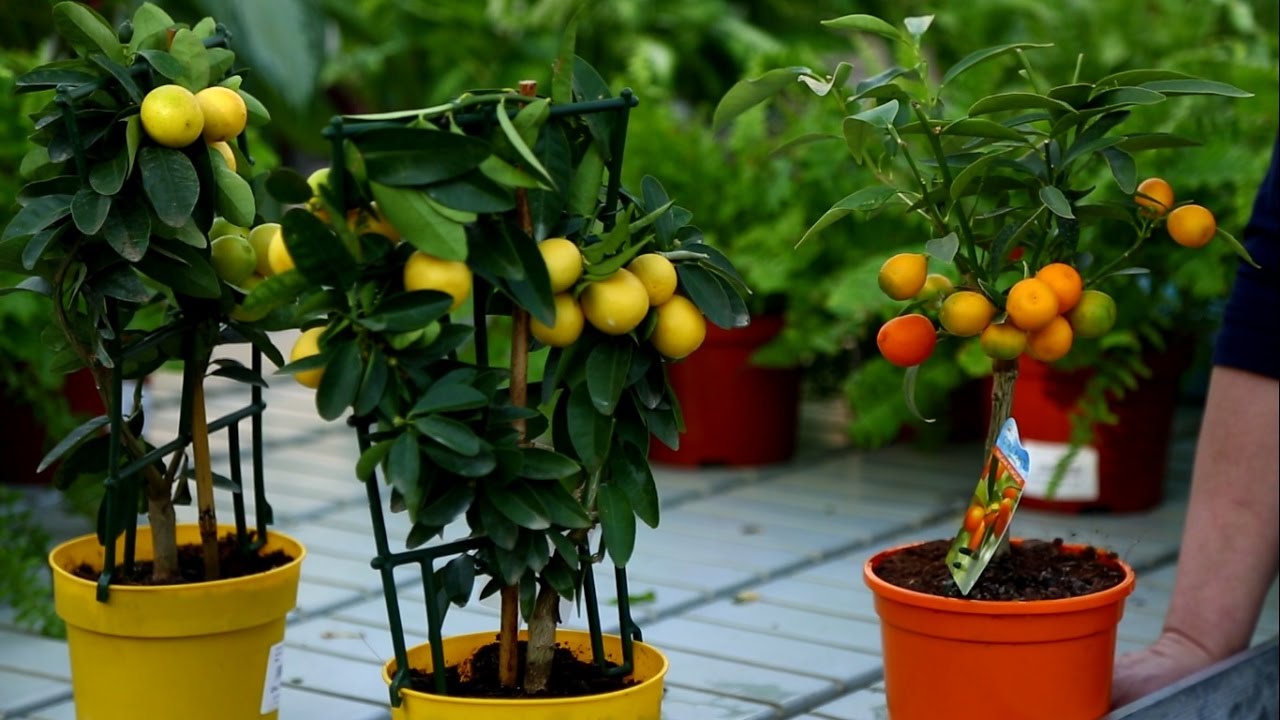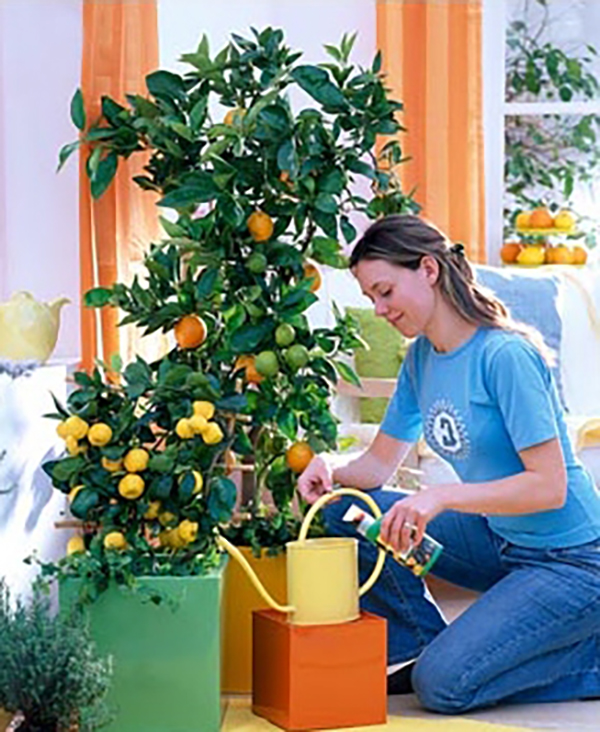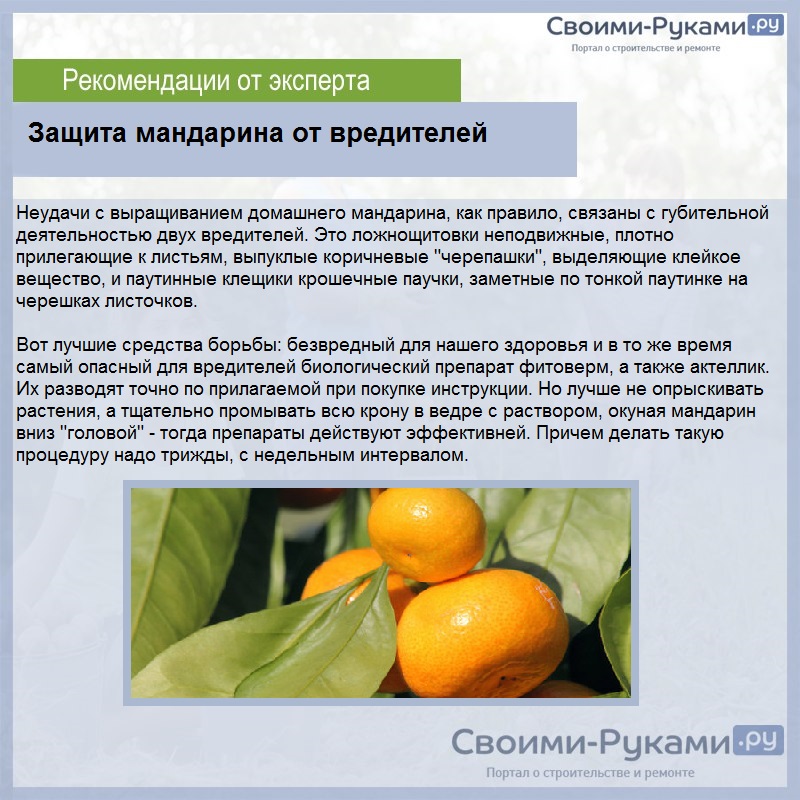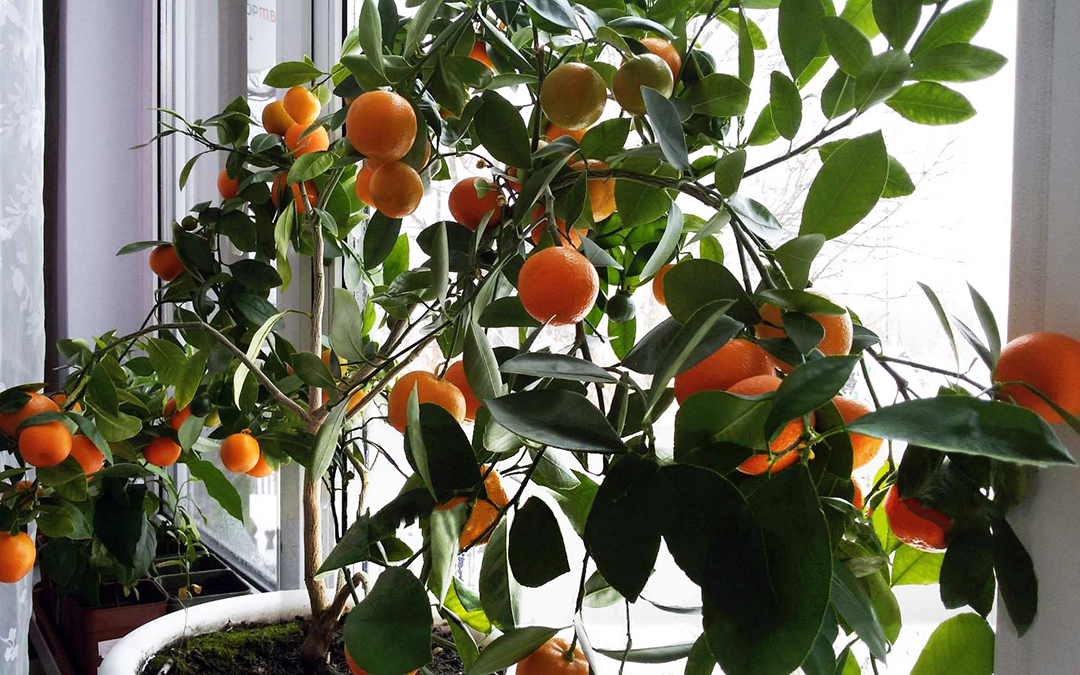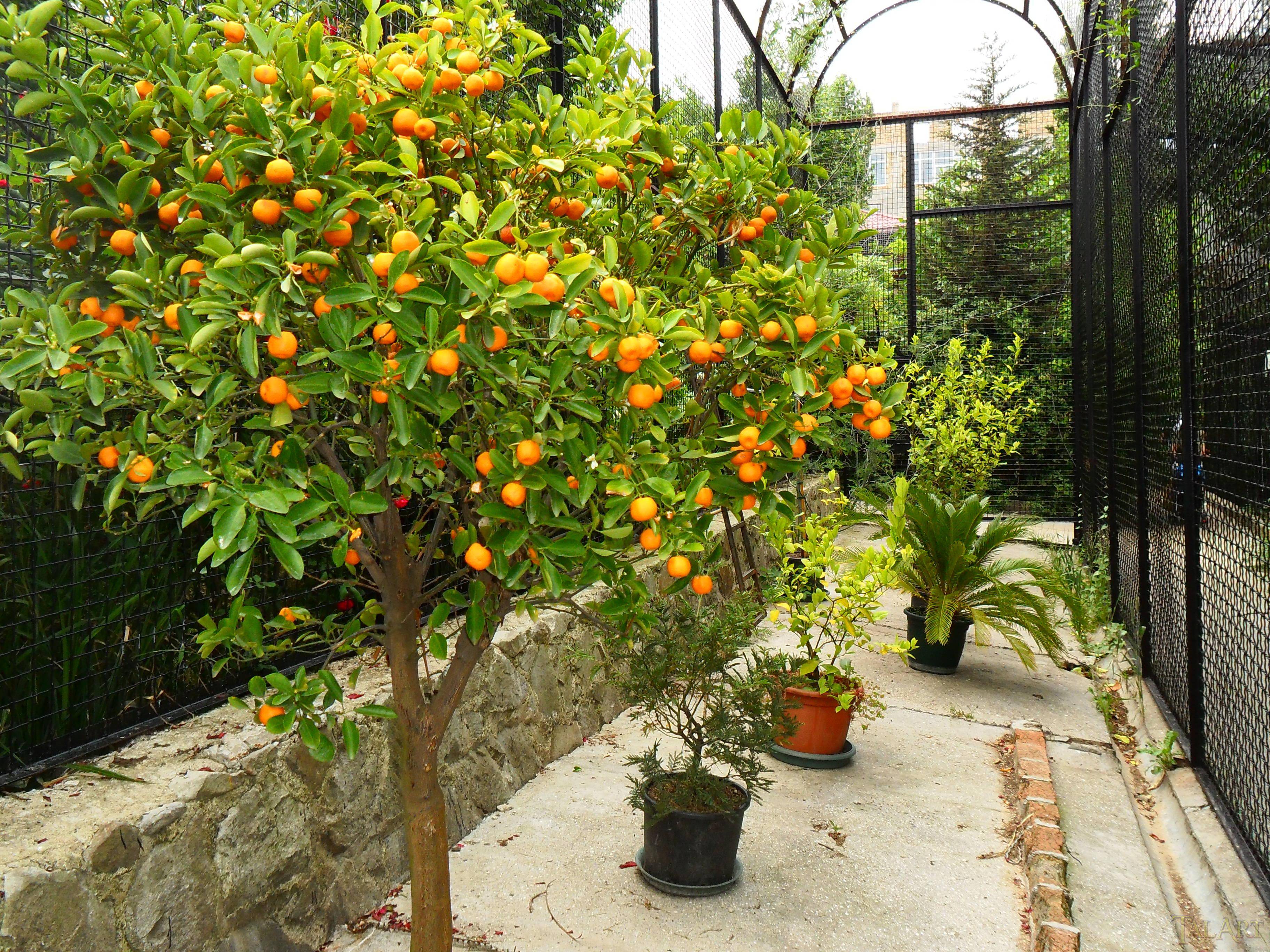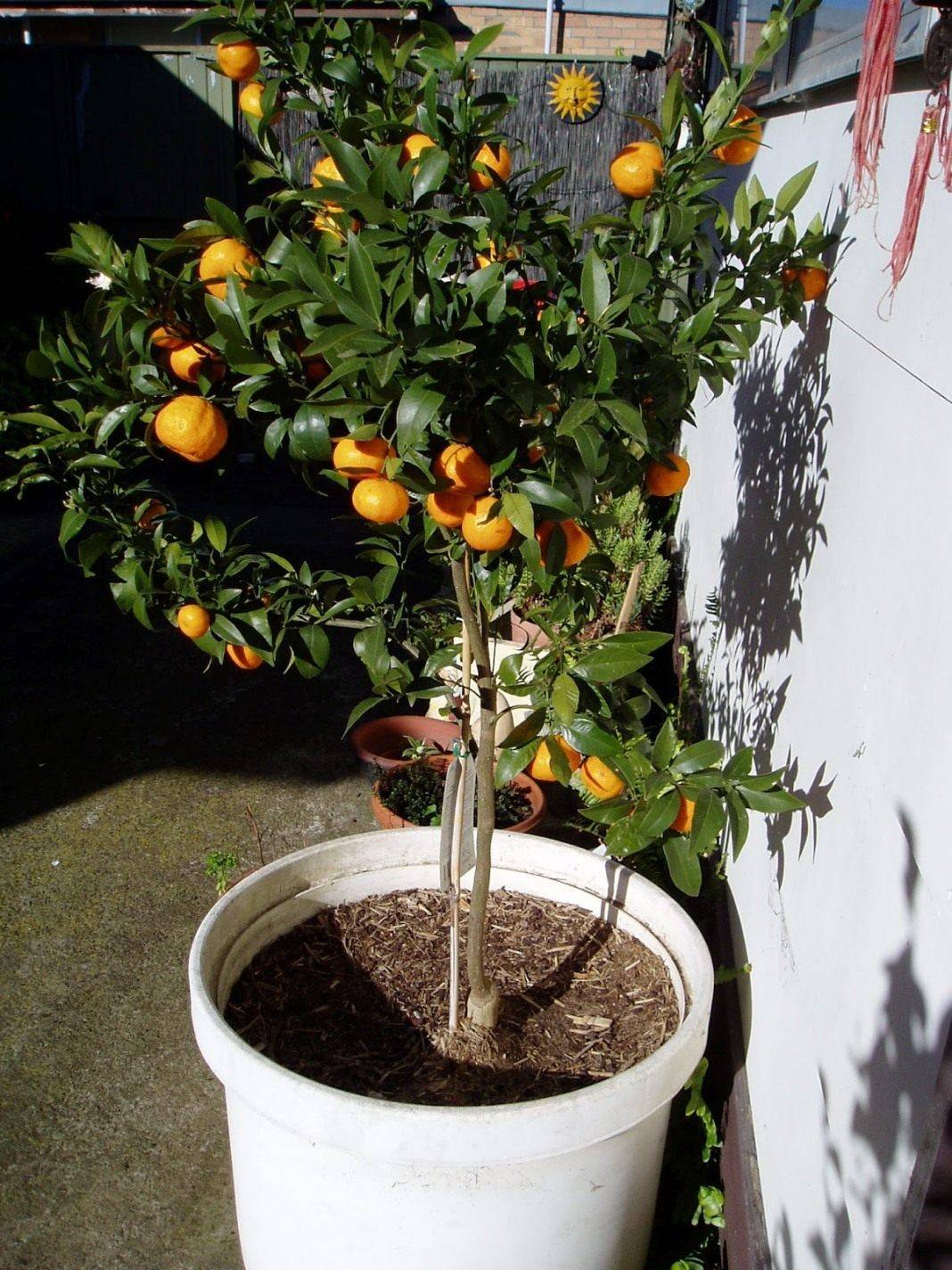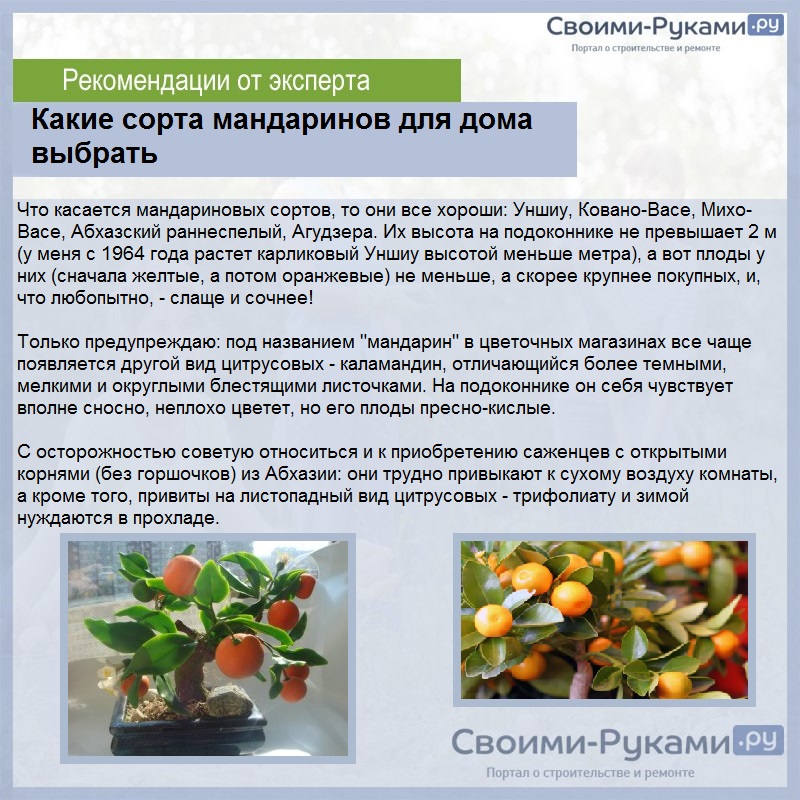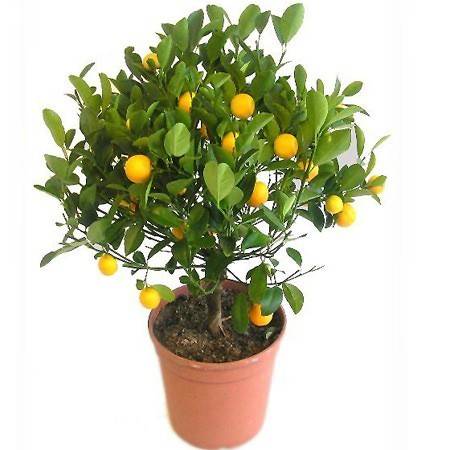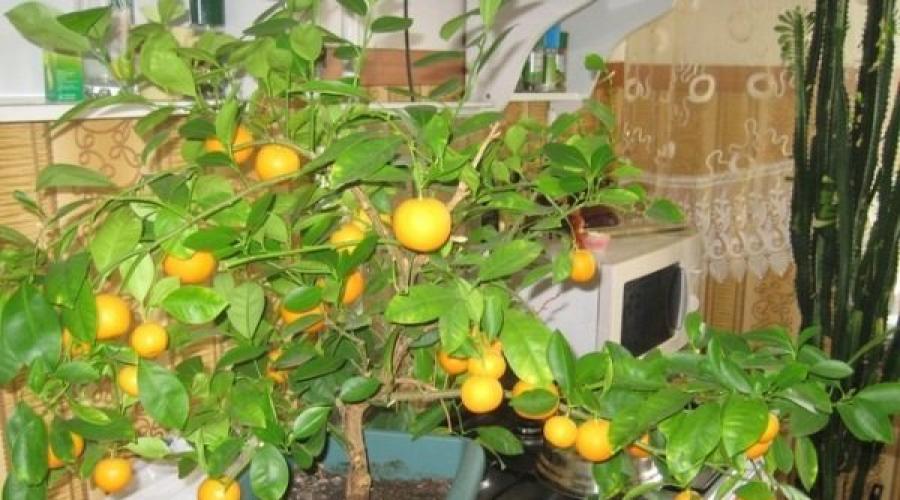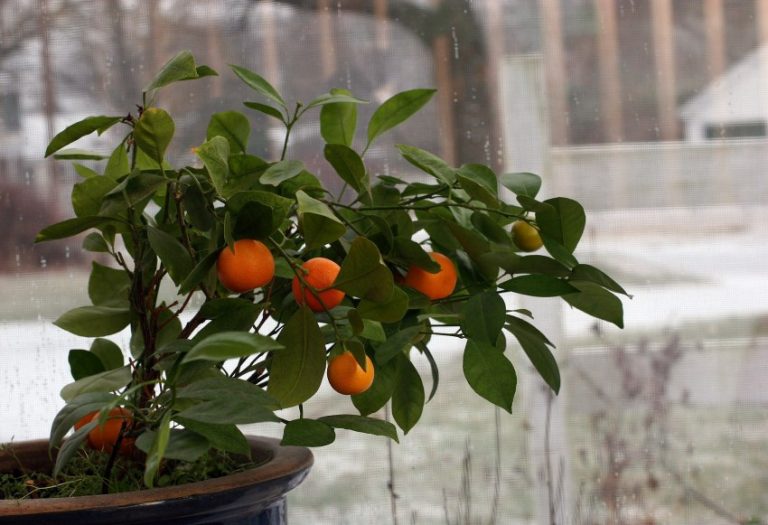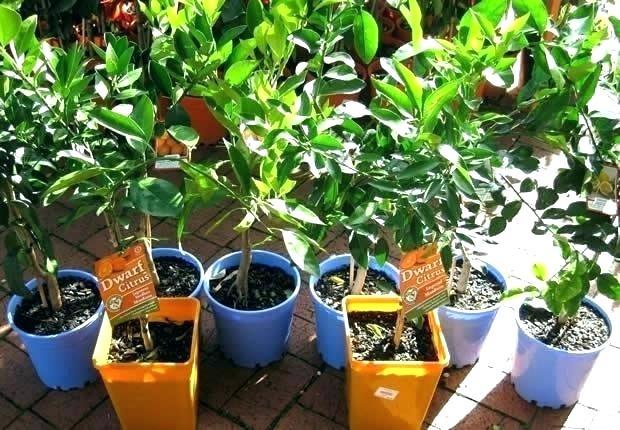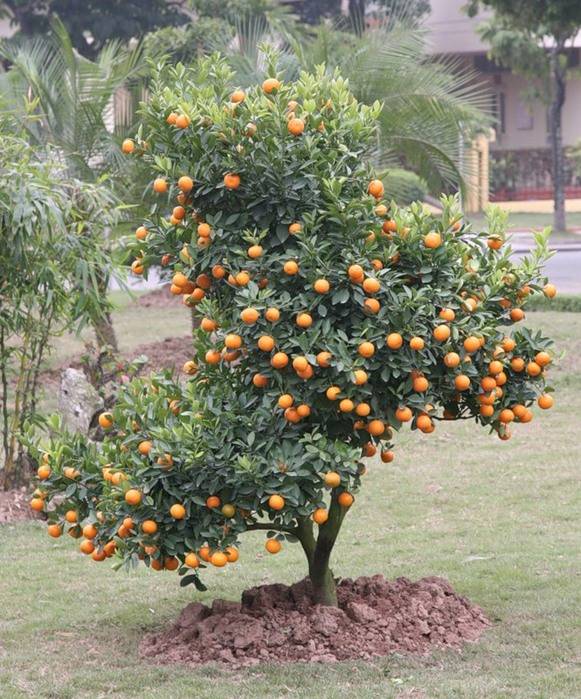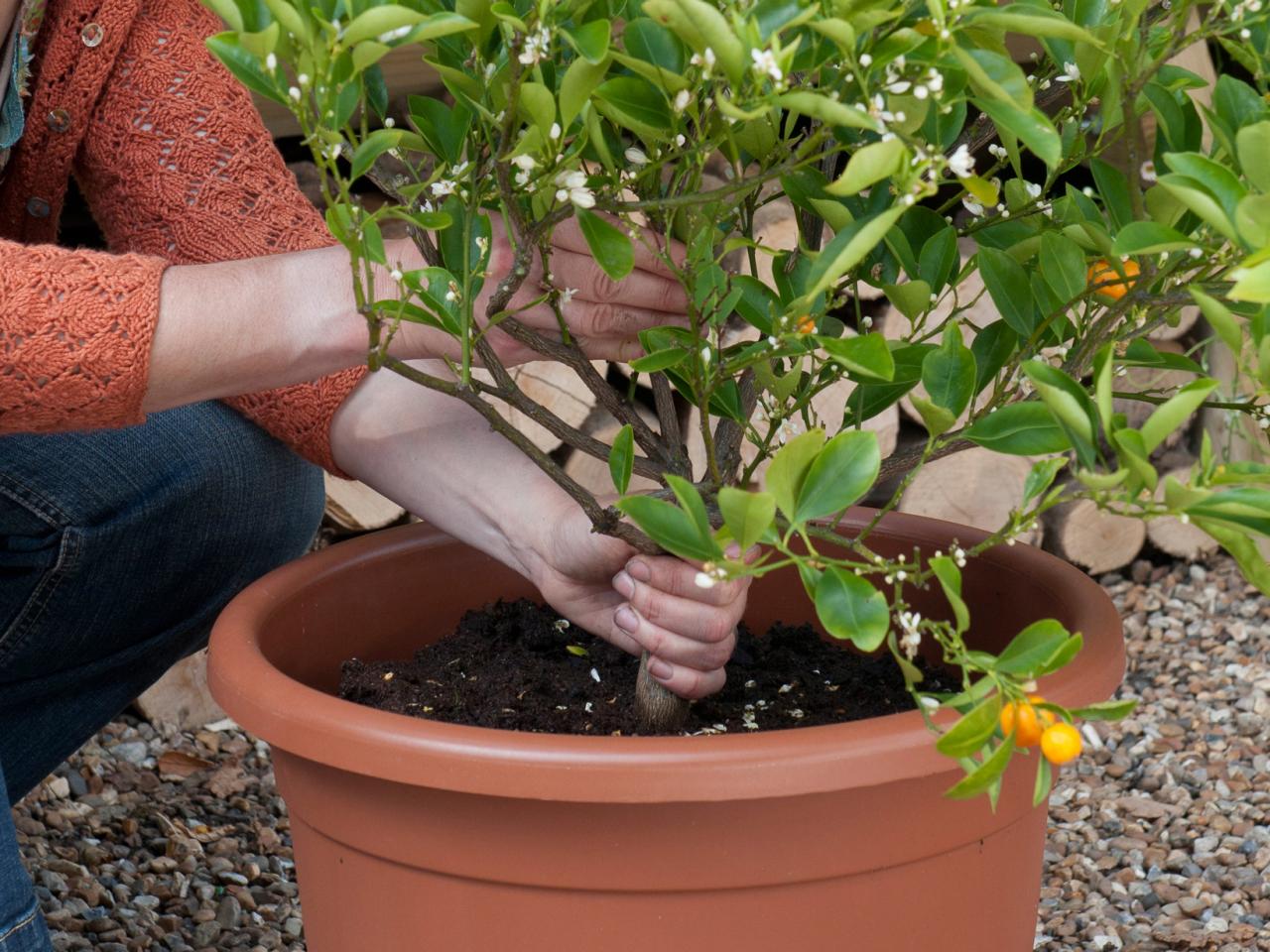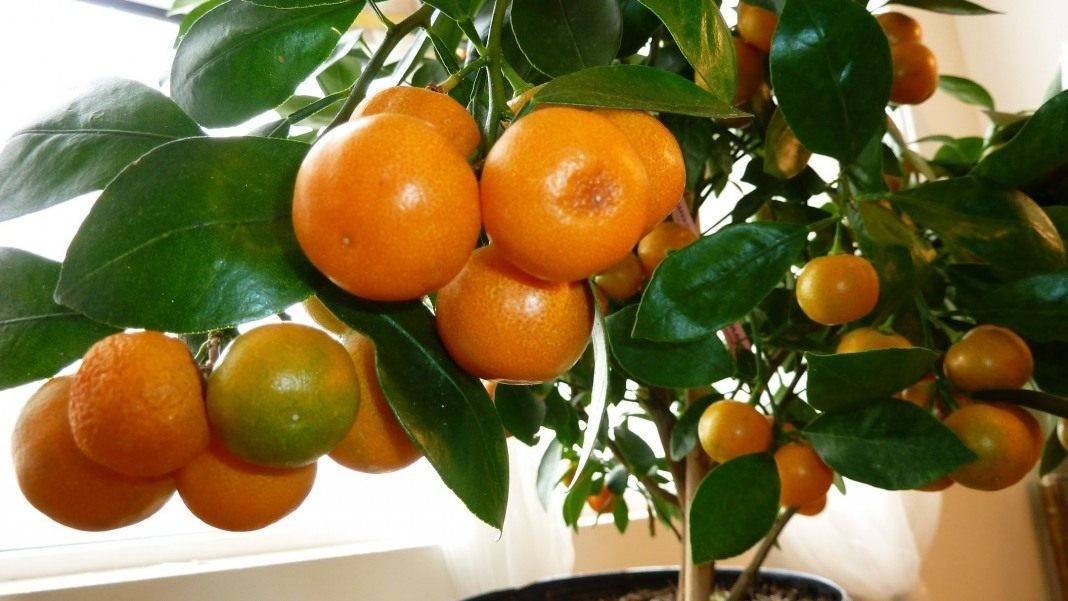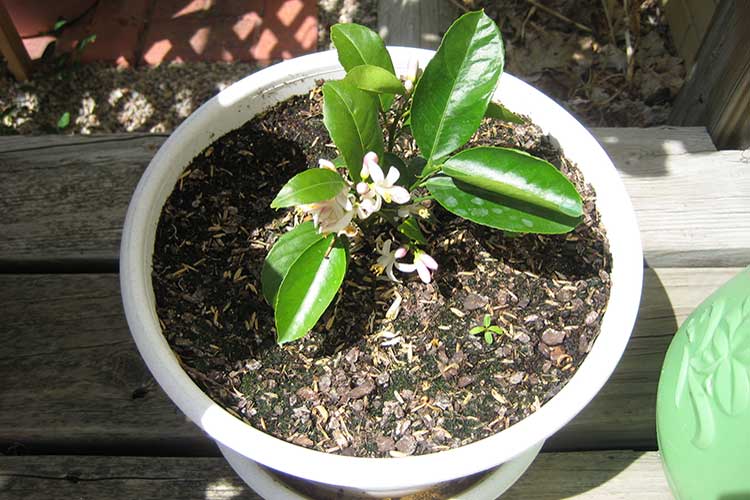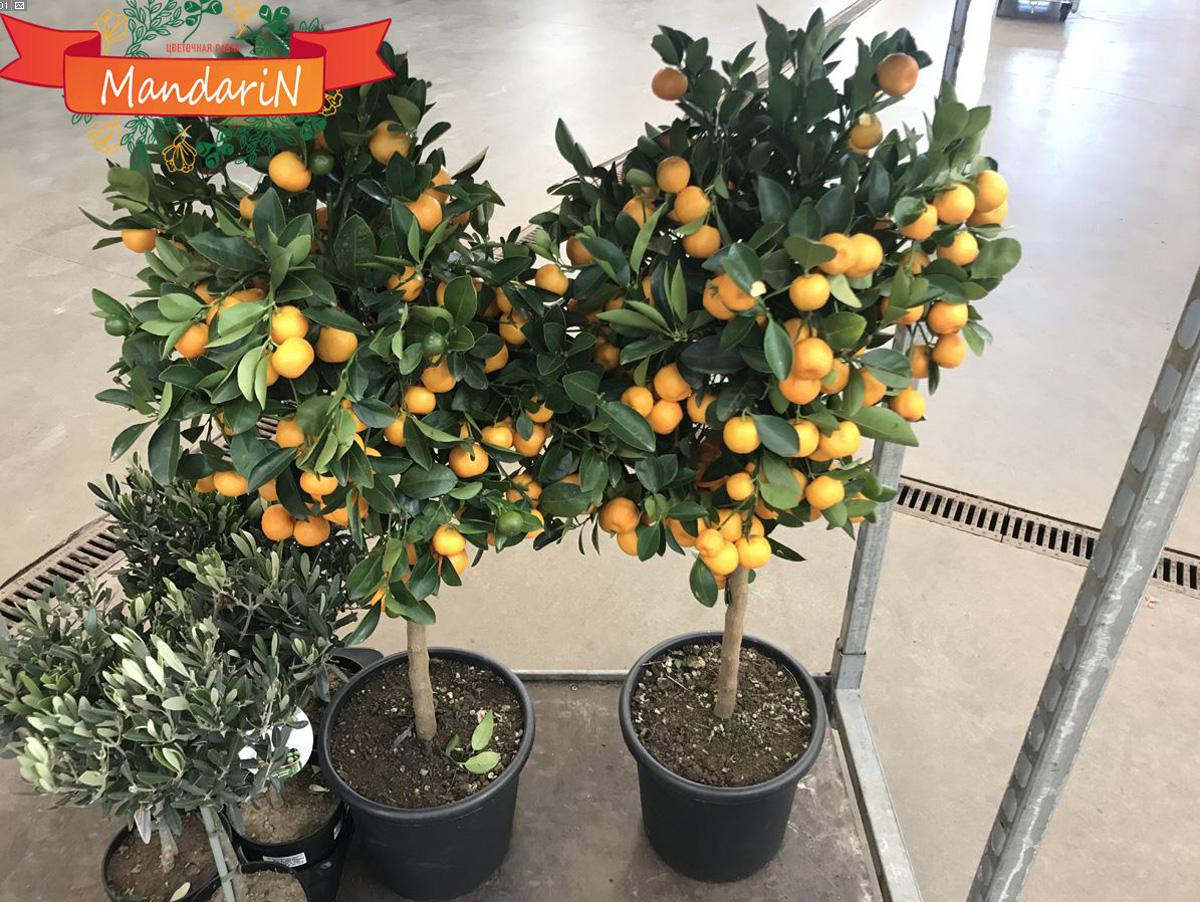Transplant timing
When is it better to transplant an indoor tangerine? Experienced gardeners do this in the spring, immediately after the end of wintering, but before the sap flow begins. Then the tree will quickly take root and easily survive stress.
If the mandarin looks unhealthy, it is transplanted regardless of the season. In other cases, the following scheme is followed:
- When grown from a stone, they dive when 2 true leaves appear on the seedlings, into a container with a volume of 200-300 ml. The second time is transplanted when the root system fills the pot. In the first year, 2 to 3 transplants are carried out.
- Before the first flowering (the first 3-5 years), the tangerine is reloaded once a year.
- After the first flowering and fruiting, the tree is replanted every 3 years.
- Trees over 10 years old that have reached their optimal size are not transferred to a new pot, but the topsoil is replaced annually.
Care rules
After planting, a tangerine at home needs careful care, especially in the first years of life. Indoor citrus does not require much cost and effort, so even a novice florist can grow it.
Lighting
This is one of the main conditions for caring for a tangerine at home. Tropical crops require good and long-lasting daylight throughout the year. Therefore, a tub or flowerpot with a tree is placed on the southern, southwestern or southeastern windowsill.
Homemade tangerine does not react well to sudden changes in temperature and does not tolerate drafts. In such conditions, the plant massively sheds foliage and may die.
With the onset of warm spring days, the plant can be placed on a balcony or loggia, in the summer it can be placed outside, where there is protection from the scorching sun.
Temperature
For a tangerine at home, a certain temperature regime is required - from +16 to +18 ° C. Then the plant begins to bloom and bear fruit successfully.
In summer, indoor tangerines can easily tolerate heat and temperatures up to +40 ° C.
In the winter season, the plant is given the opportunity to rest - it is moved to a room with a temperature of no higher than 14 ° C. In such conditions, the growth and flowering of citrus stops until spring.
Humidity
The basis of tangerine care at home is the optimization of the humidity level - at the level of 65-70%. To ensure high humidity, you should regularly irrigate the tree, place pallets with water or containers with moistened expanded clay next to the pot.
Watering
In winter, for a tangerine houseplant, use settled water at room temperature. Water the tree no more than once every two weeks. In the spring and summer, the frequency of watering is increased and moisture is produced as the earthen coma dries out.
Indoor tangerine does not react well to overflows, so the plant should be watered in small doses. The water flowing into the tray should be poured out to prevent the appearance of mold in the lower layer of the earth and rotting of the roots.
The citrus plant responds well to the soul with warm water. The foliage is washed once a month. Before irrigation, the soil is covered with polyethylene. Additionally, the plant is sprayed every day with warm water from a spray bottle.
Top dressing
For a tangerine at home, care includes regular fertilization. Citrus needs organic and mineral fertilizing, which is applied to well-moistened soil. Slurry or ready-made complex fertilizers for citrus fruits are well suited as food.
The tree is fed throughout the growing season no more than once every two weeks. For the winter, feeding of the plant is stopped, since during this period the resting phase begins.
To enhance fruiting, the tree can be fed with a fish soup. 200 g of fish products are poured with two liters of water, boiled for half an hour. Then they cool, filter and water the soil around the trunk circle. Such dressing is applied in a complex with the preparation "Mandarin". It is used for plants with a height of at least 1 m.

Unshiu variety at home bears fruit for 3 years of life
Transfer
As it grows, the decorative tangerine at home should be regularly transplanted into a new container 2-3 cm larger in diameter than the previous one. The transplant is carried out by the method of transshipment of an earthen coma with the addition of fresh nutritious soil mixture.
The first transplant procedure is performed 3-4 years after planting at a frequency of 1 time per year. Adult plants do not bother, they only periodically replace the surface layer with a new nutrient composition.
Trimming and pinching
The pinching procedure stimulates fruiting and the growth of young shoots. Pinching is performed in early spring, shortening the apical shoots by a third of the length.
To avoid the appearance of diseases and parasites, sanitary pruning is carried out - all broken off, shrunken and weak branches are removed.
Flowering and fruiting
Growing at home, a tangerine in a pot can bloom endlessly without entering the fruiting phase. To stimulate this process, you should remove some of the flower buds and fruit ovaries, which take strength and energy from the tree. This procedure is carried out on the basis that at least 15 leaves should fall on 1 fruit.
Tangerine care
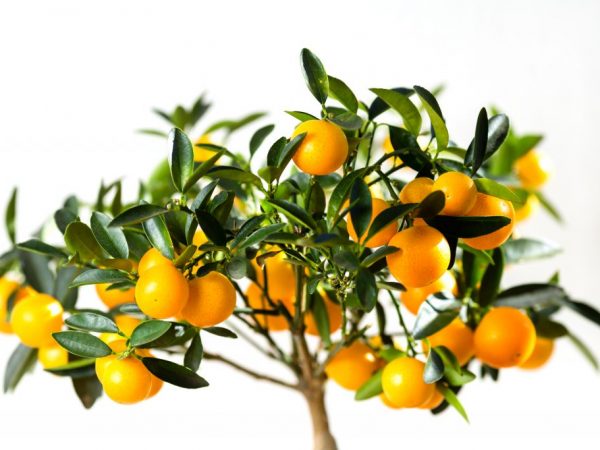
Create good conditions for the plant
Caring for a tangerine at home consists of the usual tricks. It is advised to provide the plant with:
- optimal temperature;
- lighting;
- watering and moisturizing;
- feeding.
Temperature
In summer, the tangerine tree does well at temperatures between 20 ° C and 25 ° C. During the day he is taken out into the open air. If the nights are warm, the bush is left outside. When the temperature drops, it is better to take the tree into the house so that it does not freeze.
In spring, when flowering begins, the temperature is lowered to 18 ° C-20 ° C. If it is higher or lower, the flowers will fall off and the fruits will not be tied. In winter, indoor tangerines are provided with peace. The optimum temperature for him at this time of the year is 5 ° C-10 ° C. At any time of the year, the plant must be protected from drafts and sudden temperature changes.
Lighting
The tangerine tree loves light and is boldly left in the sun. It is good to place the plant on a southern, eastern or southeastern window sill. Direct sunlight is not harmful, but it is still recommended to shade the plant at noon. Lack of light causes a slowdown in growth, the leaves become smaller, take on an unhealthy appearance, and fall off.
Growing tangerine trees in winter has its own characteristics. At this time of year, the day is short, so the plants are provided with additional lighting. A phyto light bulb is used, which is connected to a chandelier or table lamp. The duration of daylight hours is increased gradually so that the tangerine tree does not shed its leaves.
Watering and moisturizing
At home, tangerines should be watered frequently. In the summer, you will need several waterings per day. In winter, this is done 3-4 times a week at a room temperature of 10 ° C-12 ° C.
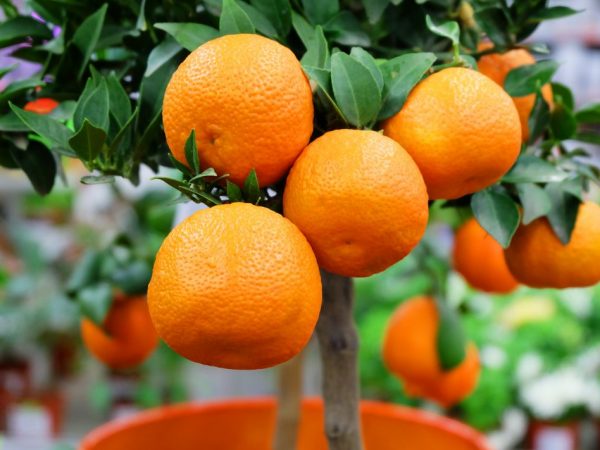
The tree needs to be watered frequently
The following factors affect the volume of water:
- the size of the tangerine tree;
- the size of the pot;
- air temperature;
- the duration of daylight hours and the intensity of illumination.
Watering is controlled by the state of the earthen coma. It should not be too wet, stagnation of water in the pot is unacceptable. Indoor tangerine tolerates drought normally, does not die, but lack of liquid causes leaves to drop.
Mandarin is a moisture-loving houseplant. Water is sprayed at a distance of 5-10 cm from the crown
The procedure is carried out extremely carefully when the tangerine is in bloom. Make sure that the liquid does not get on the flowers
It is recommended to spray from a special sprayer.It is most convenient to keep it on the windowsill.
Top dressing
Growing a healthy tangerine at home is impossible without top dressing. There are few nutrients in the soil of a small box, they need to be added additional. Complex mineral fertilizers containing phosphorus, potassium and nitrogen are suitable. They are liquid and powder. Before feeding, the concentrate is diluted with settled water according to the instructions. Then the tree is watered or sprayed with the concentrate over its crown.
Indoor tangerines begin to feed in early spring, after an increase in daylight hours. This is done every 2 weeks. A minimum amount of fertilizer is applied first. When flowering begins, the amount is gradually increased. Top dressing is finished at the end of September.
How to plant a tangerine at home
To plant a tangerine at home, there are many features to consider. Thanks to strict adherence to all the rules, it will be possible to get a strong viable plant.
What is required?
First of all, you should prepare everything you need to carry out planting work. This will require a special substrate, pot, planting material.
Capacity
At the initial stage of growing a plant, it is permissible to use a container of any size - it can even be an ordinary plastic glass. Subsequently, the tangerine tree is grown in a pot up to 4 liters in size. Before filling the container with earth, it is worth laying drainage on the bottom. This layer may consist of crushed nutshells or small stones.

Specialized soil
Mandarin is bad for acidic soil. Therefore, before buying land, you should make sure that there is no peat in its composition. When self-preparing the soil, it is worth giving preference to a light composition that allows air to pass through well. It can be a mixture of turf, sand, leafy earth.
Planting material
Most often, tangerines are grown from seeds. To do this, it is worth buying ripe fruits and pulling out the seeds from them. It is best to use at least 5-6 seeds, since not all of them sprout. Also, the tangerine tree can be obtained from cuttings.
Preparation of planting material
To achieve success in growing a crop, you should pay attention to the preparation of planting material.

Seeds
To grow tangerines from seeds, planting material should be thoroughly rinsed and placed on a flat surface. When the bones are completely dry, it is worth starting their preparation for planting work.
For this, the seed should be soaked. It is recommended to take a clean and damp cotton cloth, wrap the bones in it and leave for 2 days. Pouring water over the napkin is not recommended.
An alternative option is a hydrogel. This product will replace a damp cloth. For the procedure, it is recommended to mix the powder with water, as a result of which a jelly is formed. It is worth placing bones in it. For several days, you can not worry about the drying out of the planting material.
Cuttings
Propagating a citrus plant by cuttings is much easier than growing it from seeds. For this purpose, it is worth preparing a healthy shoot, which contains 1-2 leaves.

After that, it is recommended to do the following:
- Take a plastic pot with drainage holes and place a stalk in it. Cover the structure with a glass jar on top.
- The plant will take root only after 2-3 months. During this period, it is forbidden to transplant or spray it.
- When a mandarin grows, it is allowed to move it to a large pot. In this case, the thickness of the trunk should be 1 centimeter.
Timing and technological process
You can plant tangerines at any time of the year.
At the same time, it is important to provide him with an adequate temperature regime and humidity parameters. To carry out planting work, a drainage layer of a maximum of 5 centimeters in thickness should be placed in a tree container and filled with moistened soil
It is recommended to plant seeds immediately after extraction from the fruit. They should not dry out.
The timing of the emergence of shoots depends on the type of plant and external factors. Usually, seedlings begin to develop 1 month after planting. It is not recommended to cover the container with bones with foil. Tangerines grown in such conditions will have to be additionally adjusted to room temperature.

We create optimal conditions for germination and rooting
To root a stalk or germinate seeds, it is important to provide the correct temperature, humidity, and light conditions. Growing tangerines indoors is quite difficult.
This process requires compliance with a number of requirements.
Where to place the tangerine tree pot
The pot should be placed on a sunny windowsill. It is desirable that the sun's rays fall on the plant in the first half of the day. For growing this crop, the southern or eastern window will be the best option. It is also permissible to place a mandarin in the southeast. When placing a plant on a southern window during the period of the greatest activity of the sun, it should be shaded.
Temperature regime
The suitable temperature for tangerine is +20 degrees. At the same time, higher parameters will not harm the plant.
If the pot is located on a windowsill, it is important to worry about window insulation.

Humidity and lighting
Daylight hours for an escape that has begun to develop should be at least 12 hours. When growing a culture at home in winter, it is worth using phytolamps. It is recommended to moisten the soil with ordinary boiled water without unnecessary impurities.
Watering
How to properly water a tangerine tree? In summer, this should be done often and abundantly. In winter, you can water it twice a week. The soil in the pot should not dry out completely. Drying of the top layer of the soil testifies to the need for watering.
You can check if watering is required experimentally. You just need to take a pinch of earth in your fingers and squeeze. If it crumbles, watering is necessary. Some flower growers recommend taking hot water, which is supplied centrally. It is less chlorinated and more soft. They cool it in advance and defend it for a day. This procedure must be performed with any water for this tree.
In winter, water for irrigation must be heated to + 30 ... 35 degrees. Otherwise, the risk of hypothermia of the roots of the plant is likely, and it will wither. In summer, the water heats up on its own when standing. If you follow these rules, a homemade tangerine tree will bear bright fruits.
Suitable varieties
There are many varieties of the tangerine tree, but the problem is that not all hybrids can get along in mid-latitude climates. Many species grow in the Near and Far East, which means there is little chance that these same species will be able to exist in our territories. Therefore, people have learned to breed hybrids that are more resistant to weather changes.
Clementine
It is a hybrid of mandarin and orange. It was created in 1902 by Father Clemen (priest and breeder). The form of Clementine is similar to the form of tangerine, but has a more pronounced sweet taste. The tree is 5 meters tall. This tree is often used to decorate gardens. The diameter of the mandarin fruit is 6 centimeters. The leaves are very dense. The fruit always has a fresh look, unique aroma, juicy pulp.
Dwarf varieties are chosen for growing at home. This plant contains many vitamins, so it will be useful for colds. Clementine needs abundant sunshine. The soil is constantly watered and fertilized. In warm weather, the plant is taken out onto the street or balcony.
Murcott
The variety was developed in the United States in the last century. Medium-sized plant, upright. Egg-shaped leaves with a sharp end. A productive variety, but the fruits do not ripen at the same time. The fruit is medium in size, the skin is tight to the flesh. Mandarin has 11-12 slices and a lot of seeds. The taste is honeyed with notes of mango. Also picky about sunlight. Watering is carried out 2 times a week. Make sure that the soil absorbs moisture well.Fertilizers are applied under the mandarin at least once a month.

Shiva Mikan
The tree is vigorous, 6 meters high. The spines are small, the crown is spreading, the branches are straight. The fruits are small, the weight of one is 17-22 grams. The apex is flat, slightly depressed inward. The pulp of the tangerine is juicy, sweet, loose. The rind is light orange in color. It is easily separated from the pulp. Fruits ripen in October. Mandarin blooms in May-June.
Vasya
One of the most popular varieties of tangerines. In an apartment, his height is 0.5 meters. Leaves are dense, leathery. There are no thorns on the branches. The advantage of this hybrid is that you don't have to form a crown. Maturity begins in the third year of life. The fruit has 8-12 lobules. The rind is very thin. Mandarin needs sunlight, otherwise the fruit will sing for a long time, and there will be no seeds. Fruit weight 50-70 grams. The harvested crop can be stored for a long time.
Forged
It is considered one of the best indoor tangerine varieties. The shape is flattened, the leaves are large, pointed at the tip. The crown is wide, does not require shaping. Petioles are long, narrow. The size of the tree is 0.5-0.7 meters. Fruit weight 50-60 grams. The peel is 3 millimeters thick, light orange in color. The tree needs a full sunny day, so additional lighting is sometimes used. The fruit blooms in late spring, bears fruit in mid-October.
Micah
Abundant flowering, white flowers, sometimes with a yellow tint. The size of the tree is from 50 to 80 centimeters. Thin peel, juicy pulp, 8-13 lobules in the fruit. The crown is not formed, since the branches are flexible enough. Fruit weight 60-70 grams. Well suited for growing on a windowsill. The plant loves high humidity. Up to 100 fruits are harvested from a tree per year.

Miyagawa
A dwarf mandarin variety, its growth does not exceed 60-90 centimeters. Fruiting begins in the second year. The plant needs the sun, and it is also protected from drafts. The flowers are small, white, 5-6 petals. Fruiting early, fruits are expected in September-October. There are 8-10 segments in the fruit. Tangerines are spherical, sometimes flattened. Weight 100-110 grams. The peel is bright orange in color, the pulp is very juicy, sweet and sour. The variety itself is native to Japan.
Unshiu
Originally from Far Asia. The leaves are large, leathery, deep green. The growth of a tree at home does not exceed 1.5 meters. The fruits are tasty, sweet and sour. There are 8-10 segments in the fruit. The plant loves high temperature and humidity. The plant is protected from sunburn and is not left under the scorching sun. Mandarin blooms in spring, white flowers, 5 petals.
Homemade tangerine care rules
The tangerine tree in indoor conditions forms a compact flowering tree. Healthy tangerine has a decorative function in the interior, and during the flowering period it intensively releases aromatic substances.
Optimal conditions
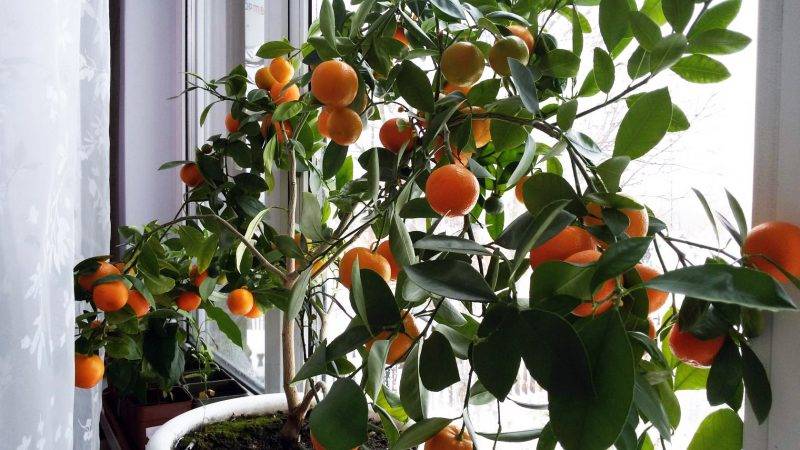
Mandarins are demanding for light and warmth. Budding, flowering and tying of mandarins occur at an average temperature of + 15 ... + 18 ° С. In winter, the culture is kept in a bright and cold room at a temperature of + 12 ... + 13 ° C. Mandarin does not tolerate the lack of a change of seasons and stops bearing fruit. Therefore, a pot with a tree must be placed in a cool room.
The tree responds well to bright, diffused light near an east or west window. Mandarin content is allowed on the north side. In the summer, the sprout is shaded from aggressive sunlight, which burns the leaves. To do this, the bush is wrapped with wet gauze or waxed paper is glued to the window.
To increase daylight hours in winter, fluorescent lamps are installed above the pot. The optimal duration of daylight hours for citrus fruits in winter is 8-9 hours.
Watering
In summer and spring, the plant is watered abundantly daily with warm water. In winter, the amount of watering is reduced to 1-2 times a week, irrigated only with warm water.Overdrying the earthen coma in winter leads to the loss of leaves and fruits and even the death of the plant.
Mandarin is sensitive to air humidity, so regular spraying from a spray bottle has a good effect on the state of the vegetative system. Plants kept in rooms with central heating are sprayed daily.
Placing a wide bowl of water next to the radiator helps regulate humidity.
Pruning
Mandarin needs crown molding, because in the wild the plant reaches 4-5 m in height. Having reached a height of 45-50 cm, the seedling often branches on its own. Pinching helps to stimulate the formation of side shoots of the first order.
After 4-5 leaves the next year, all the shoots are pinched again to stimulate the formation of shoots of 4-5 orders of magnitude, on which fruiting occurs.
If desired, the mandarin crown is given a round, oval, drop-shaped shape.
Transfer
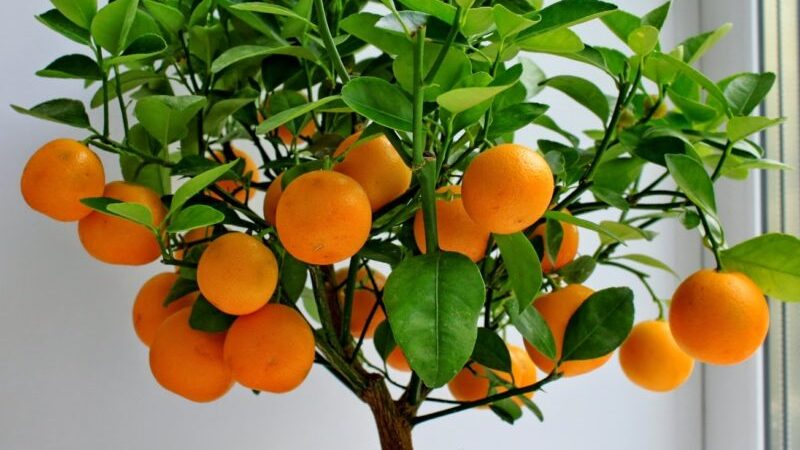
Until the onset of three years of age, trees are transplanted annually, then every 2-3 years. The transplant is carried out in mid-March, before the onset of active vegetation processes.
The plant is buried so that the root collar is at ground level
The root ball is transferred carefully, because
tangerine can die due to damage to the root system.
When transplanting an adult plant, each time a pot is chosen with a diameter of 4-5 cm larger than the previous one, for free growth and development of roots.
The soil
The best soil for a tree is considered to be a light peat substrate for citrus fruits or a universal earthy mixture. Young and mature plants need different quality soil composition.
Prepare the soil yourself as follows:
- for the first planting: 2 parts of turf, 1 part of leafy soil, 1 part of humus and 1 part of sand;
- for adult plants: 3 parts of turf, 1 part of leaf, 1 part of humus, 1 part of sand and 0.5 part of clay.
At the bottom of the pot for citrus trees, drainage 1-3 cm high is always covered (depending on the age of the plant). Trees older than 7 years are not transplanted, but the top layer is renewed annually by 1/3 of the pot.
Tangerine tree watering rules
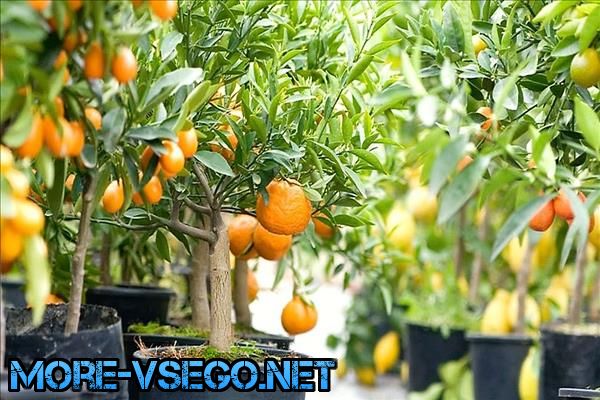
1. If the soil in a tub with a plant dries up, the risk of spider mites is significantly increased. Always make sure that the soil contains a little moisture, it should not be wet.
2. In summer, watering is carried out every day, in winter, the procedure is reduced to 2-3 procedures per week
Therefore, it is important to know how to care for a tangerine tree in a pot. Feel the ground with your finger: if dry, pour in a small amount of water
3
Always pay attention to the pallet before watering the tree. If there is a lot of water, the plant simply does not have time to absorb liquid.
At home, watering should be stopped. Wait for the water in the pan to dry.
4. If you don't do the right thing, the root system starts to rot. Fungus may also develop. Use settled (rain, filtered) water.
5. The amount of water injected varies depending on the temperature in the room and the size of the plant. If the room is hot enough, a small tree needs up to 1 liter. water. For large, the indicator should be increased by 4 times.
6. Be sure to warm up the water to 39-41 degrees, then water the plant. It is enough to immerse your hand in liquid to roughly estimate the temperature. If you are comfortable, this water is what you need.
7. Pour the liquid exclusively into the rhizomes. Foliage with a trunk does not tolerate excess moisture. It is allowed to separately moisten the crown with a spray bottle. Distribute water evenly. When the mandarin is in bloom, the liquid should not get on the buds. Water the plant in the morning.

Basic rules of care
After the mandarin has taken root, it is important to provide it with proper care. Otherwise, the plant will be sick and will not survive the winter.
Temperature
After the tangerine takes root, the temperature in the room where it grows is maintained within + 16 ... + 20 ° С. When the tree blooms, the temperature is raised to + 25 ° C. In winter, choose a room with indicators of + 10 ... + 12 ° C.
Lighting
In the warm season, the tangerine is placed on the eastern or western windowsill. In winter, it is recommended to rearrange the plant to the south window.
Humidity
Mandarin is sprayed daily with warm, settled water. In winter, if the plant is near a battery, a humidifier or a container of water is placed next to it.
Watering
In summer, tangerine is watered as the topsoil dries out (every day). In winter, one watering per week is enough. Use warm, settled water.
Top dressing
Tangerines are fed from spring to autumn twice a week. Mineral and organic dressings alternate. As fertilizers, use special mixtures for citrus fruits or folk remedies. Popular home dressings include tea and coffee, chicken manure diluted 1:10 with water, infusion of vegetable peelings, fish broth, and ash infusion.
Bloom
In the first flowering, all inflorescences are removed. Otherwise, the plant will spend all its strength on them and die. Further, the buds are not plucked. This tree does not need artificial pollination.
Transfer
Before the first fruiting, the tangerine is transplanted once a year. It is transferred into a pot along with an earthen lump. Each new container should be 5 cm larger than the previous one. The free space is covered with soil (the same as for rooting the cutting). Add 1 part more garden soil to the soil mixture.
Plants that bear fruit are transplanted once every 2-3 years. When transplanting, the roots are cleared of soil and old shoots are removed.
h3> Formation
Formation is necessary in order for the tangerine to bear fruit and have a neat appearance. Also, this procedure reduces the risk of plant infection.
There are two types of pruning - formative and sanitary. Sanitation involves the annual removal of dry, broken and diseased branches.
Formation is carried out as follows:
- When the plant reaches a height of 40-60 cm, pinch its top. This is necessary to form first-order branches and limit growth in height.
- The branches of the first order are cut after 4-5 leaves. It is recommended to leave no more than 3-4 branches of the same order, directed in different directions.
- Do the same with the branches of the 2nd, 3rd and 4th orders. This stimulates the growth of shoots of the next order.
The cut sites are covered with garden varnish to reduce the risk of plant diseases.
Features of caring for a tangerine tree at home
No matter how the plant is planted, it requires maintaining certain conditions and careful care.
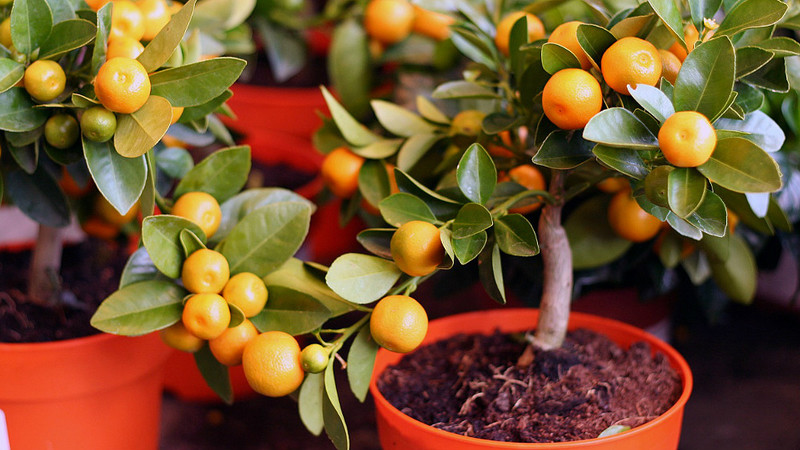
Temperature
In the summer, the tangerine feels good outside, even at night, if it is warm enough. The optimum temperature is + 25 ... + 30 ° С. In the spring and during the flowering period, the air should not warm up above + 18 ... + 20 ° С, otherwise the buds will crumble.
In winter, the tangerine is in a dormant phase at a temperature of + 10 ... + 12 ° С.
Lighting
Mandarin is a southern plant, a lover of long daylight hours. During the rest period, it needs darkening. In autumn and spring, he needs additional lighting, extending the day by 2-3 hours in the morning and 3-4 in the evening. For this, special phytolamps or ordinary fluorescent lamps are used.
Humidity
In their natural environment, tangerines grow in a subtropical climate. There the air humidity reaches 100%. But in the apartment they feel great even at 60-65%. To ensure this level, it is enough to use a humidifier or place open containers of water near the pots.
Watering
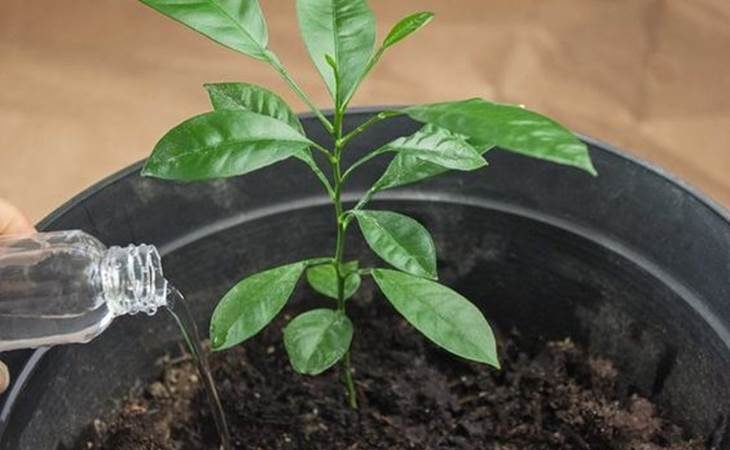
Do not use chlorinated tap water - this is detrimental to most houseplants. For irrigation, it is best to use rain or bottled water with a temperature of at least + 20 ° C.If this is not possible, tap water is defended for 2-3 days and only then tangerines are watered.
It is impossible to overmoisten the soil, to allow overdrying - too. The top layer of the soil serves as a guide - it should not have a dry crust on it. Watering is done more often in summer, less often in winter.
Mandarins are very responsive to spraying. The entire crown is moistened with warm, settled water from a spray bottle 2-3 times a week, with the exception of the buds during the flowering period.
Top dressing
At least twice a month, special complex fertilizers for citrus fruits are introduced into the soil (they are sold in flower shops). In summer, it is better to use organic manure diluted with water in a ratio of 1:10. But in this way, there is a high probability of introducing pests or pathogens into the soil.
If a transplant or flowering is to be done, or the tangerines are at rest, they cannot be fed.
Protection against diseases and pests

Mandarin is often attacked by insects and pathogens.
The main pests:
- spider mite;
- aphid;
- citrus nematode;
- shield;
- whitefly;
- greenhouse thrips;
- mealybug.
If insects are found on the plant, they are fought with insecticidal preparations: Actellik, Sulfarid, Aktofit, Ferramol. But they cannot be used during flowering or fruiting, so that harmful substances do not accumulate in the fruits.
In this case, sparing methods are used:
- pests are removed from plants by hand;
- tangerines are sprayed with soap (10 g per 1 liter of water) or vinegar (1 tsp. 9% per 1 liter of water) solution;
- if affected by a nematode that lives in the soil, the bush must be transplanted into clean soil.
Pathogenic microorganisms cause diseases of mandarins:
- Anthracnose: with excessive moisture, light spots appear on the leaves, which darken over time. The infected parts of the plant are cut off, the bush is sprayed with any fungicide.
- Late blight: brown rings on the trunks. If found, they are cleaned off, the tree is sprayed with a 3% solution of copper sulfate.
- Hommosis: brown spots on the branches, leading to damage to the bark, cracks. The infected areas are cleaned, treated with 3% copper sulfate.
- Root rot: yellowing and falling leaves. It is usually too late to save the plant when found.
Mandarin diseases caused by viruses or bacteria cannot be cured.
Mandarin grafting
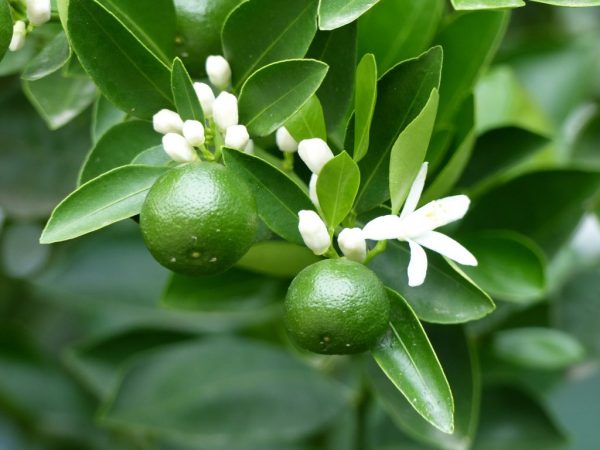
Without vaccination, the fruit will be inedible.
Growing a tangerine at home from a bone is always combined with grafting. Without this procedure, sour, inedible fruits are obtained. It is allowed to graft the plant approximately 2 years after planting. By that time, the stem of the scion has a thickness of about 6 mm. The inoculation is carried out either in the cleft or under the bark. Sometimes grafting is replaced by budding.
With any technique, the following tools are prepared:
- sharp knife;
- scotch tape, duct tape or a strip of fabric;
- garden var.
Wash hands thoroughly to avoid infection. The procedure is done quickly so that the contact of the slices with air is minimal.
Cleavage grafting
The technique is suitable for beginners and is carried out on mature trunks of 3 years old. A stalk of the selected variety with 2-4 buds is cut obliquely from 2 sides to form a wedge. The length of the slices is approximately 3-4 cm.
Then the trunk is cut in two, the depth of the cleavage is 5 cm. The cutting is inserted so that its cambium comes into contact with the cambium of the scion at least from one side. The trunk is wrapped with tape or cloth, covered with garden pitch. The tree is placed in a greenhouse from a plastic bottle or film until the stalk takes root.
Bark grafting
It takes experience to plant a mandarin plant at home under the bark. This technique is considered more advanced. First, an incision is made in the bark with a length of 3 cm. Carefully separate it from the trunk of the tangerine tree. The stalk is cut obliquely, inserted between the wood and the bark of the stock. They are wound with electrical tape and covered with garden varnish.
For the grafting to be successful, 3-4 cuttings are used at a distance of 2-3 cm from each other. As in the previous case, they build a greenhouse, the tree is regularly watered and mineral fertilizers are applied.
Budding
Planting indoor tangerine at home is easy with a single-bud cuttings. The technique is called "budding". Step by step, it consists of the following stages:
- The trunk of a tangerine tree is wiped with a damp sponge at a height of 10 cm from the ground surface.
- The bud with a piece of wood is separated from the cutting.
- An incision in the shape of the letter T is made on the bark of the rootstock trunk. The height of the cut is 2.5 cm, the width is 1 cm.
- The cut is carefully expanded, a bud with wood is inserted there, and covered with bark on top.
- Wrap with tape and treat with garden varnish, leaving the bud free.
- It is good to put an indoor tangerine in a greenhouse from a plastic bottle or plastic wrap.
The greenhouse is constantly ventilated so that moisture does not stagnate. When the stalk takes root and starts up the first shoots, the trunk of the scion is cut by a third at a distance of 5-10 cm from the grafting. From above, the cut is covered with garden var. It is advisable to tie the indoor tangerine tree to a small peg.

